Where new apartment buildings could pop up all over the South Shore due to a state law
The end of 2024 marks an important deadline for more than 100 Massachusetts municipalities to adopt zoning rules that make it easier to build apartments near public transportation.
Those municipalities that are categorized as “commuter rail” or “adjacent communities” under the MBTA Communities Act must create at least one high-density zoning overlay district of a certain size that allows for development suitable for families.
As of mid-May, a dozen South Shore communities have approved this zoning, paving the way for compliance under the state law. Four others rejected proposed rules or sought further review.
The state has warned that communities who do not submit plans would not be eligible for some state grant programs. Attorney General Andrea Campbell has ruled that communities can't avoid the requirement by forgoing the grants and would be subject to civil enforcement action. And in Milton, where voters rejected the law, the state has done just that − sued the town and taken away grants.
"The law is clear – compliance with the MBTA Communities Law is mandatory,” said Housing and Livable Communities Secretary Edward Augustus in a letter to Milton. "If we do not all come together to build more housing, we will not be able to overcome our affordability crisis. We need every community to do their part.”
What is the MBTA Communities Act?
The MBTA Communities Act was signed into law in 2021 by then-Gov. Charlie Baker as a way to boost the state’s housing stock and in turn increase housing affordability. The law requires 177 municipalities across the state to designate at least one zoning overlay district that allows for multifamily housing with a minimum gross density of 15 units per acre as of right, meaning without needing a special permit or variance. Certain rules like wetlands protections must still be followed.
Wherever the overlay district is situated, it will allow for multifamily housing as an additional type of use on top of the zoning that already exists. So, if the area was zoned for business, a developer can pitch a project that fits within the business zoning or multifamily housing zoning. Many towns have placed their MBTA multifamily zoning districts over existing commercial developments or apartment complexes.
This law does not require that multifamily housing is built, just that the zoning allows for it. Development would only be considered if the landowner decides to sell to a developer for these purposes.
These municipalities are considered by the state to be one of the following: “rapid transit” community, “commuter rail” community, “adjacent community” or “adjacent small town.”
Rapid transit communities: There are 12 in the state – including Quincy, Braintree and Milton – that were required to adopt zoning changes by the end of last year. Milton is the only one of these to reject the mandate.
The 106 commuter rail and adjacent communities have until the end of 2024 to adopt zoning rules, and 46 adjacent communities including Carver have until the end of 2025.
Each type of community is required to zone for a minimum number of units, a figure that is based on the 2020 housing stock. Generally speaking, rapid transit communities have to zone for 25% of the 2020 housing stock; commuter rail communities zone for 15%; adjacent communities zone for 10%; and adjacent small towns zone for 5%.
There are some situations where the minimum number of units is greater than this assigned percentage. But no minimums exceed 25% of the number of existing housing units from four years ago.
Here’s where the South Shore stands on adopting MBTA zoning rules.
Abington
Status of MBTA zoning adoption vote: Passed April 1
Number of units required for MBTA zoning: 1,022
By voice vote, voters nearly unanimously supported the adoption of the proposed MBTA zoning changes during the April 1 town meeting.
The overlay district covers less than a dozen parcels on the north and south sides of Summer Street between Progress and Plymouth streets. This land is situated near the Abington station on the Kingston commuter rail line. The new zoning overlay district covers existing developments such as the Woodlands at Abington Station, the MBTA station and the Abington Dog Park.
The town is considered a “commuter rail” community under the MBTA Communities Act. It is required to zone for a minimum of 1,022 units of multifamily housing, which is 15% of the town’s 6,811 housing units as of the 2020 census.
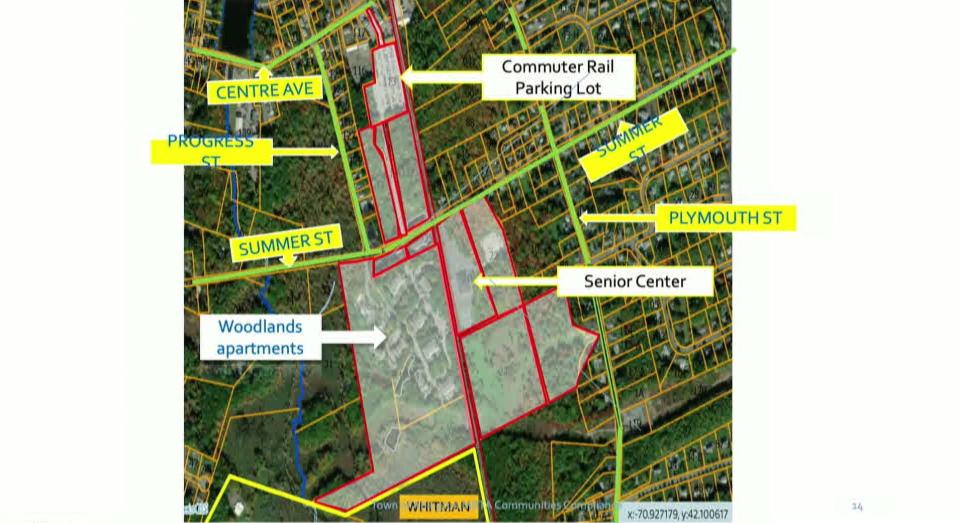
Braintree
Status of MBTA zoning adoption vote: Passed Dec. 19, 2023
Number of units required for MBTA zoning: 3,769
The Braintree Town Council adopted MBTA zoning changes during a Dec. 19, 2023, meeting. The vote was 6-2, with outgoing Councilors Stephen O’Brien and Lawrence Mackin Jr. opposing the measure.
The town spread its MBTA zoning across 200 acres and four districts: 49 acres on the Marketplace at Braintree and soon-to-be Chick-fil-A near the Union Street rotary; 127 acres south of the Braintree T station to Plain Street; 9 acres of a triangular collection of parcels South of Pearl Street and east of Hancock Street; and 18 acres on either side of the Weymouth Landing/East Braintree station of the Greenbush commuter rail line.
Braintree is a “rapid transit” community and was required to zone for 3,769 multifamily housing units, or 25% of its 15,077 housing units.
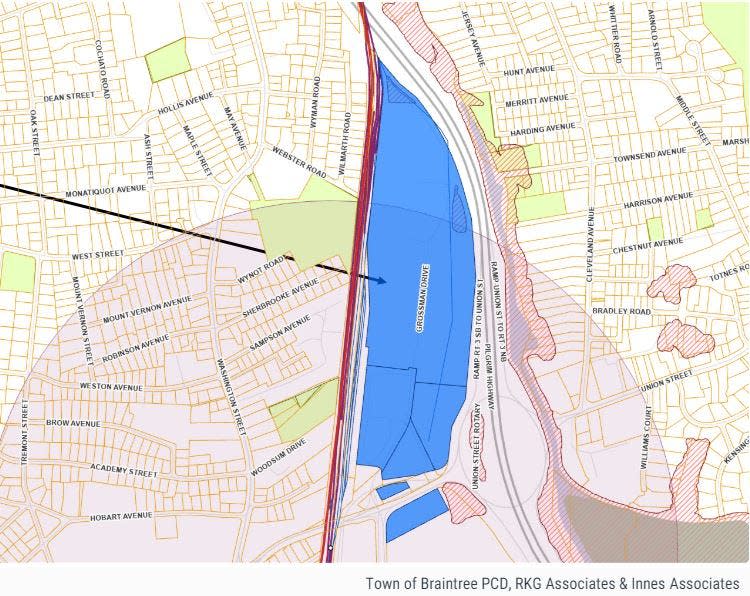
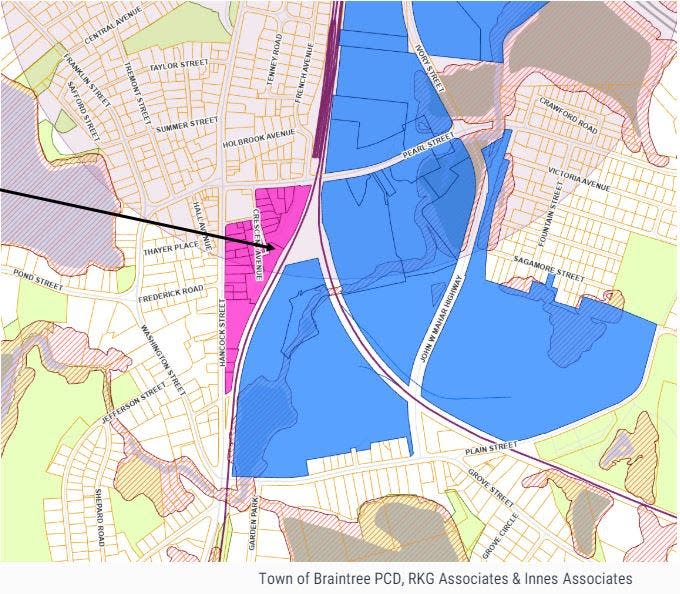
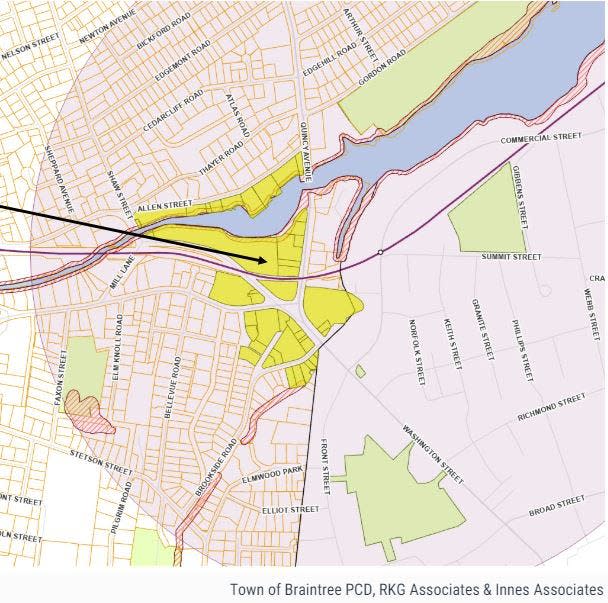
Canton
Status of MBTA zoning adoption vote: Passed May 13
Number of units required for MBTA zoning: 1,022
Canton, a "commuter rail" community, was required to zone for 1,490 multifamily housing units, or 15% of its 9,930 existing housing units. It passed town meeting by a May 13 majority hand vote.
Town officials proposed the MBTA multifamily housing zoning overlay district to sit between the Canton Junction and Canton Center stations of the Providence/Stoughton commuter rail line.
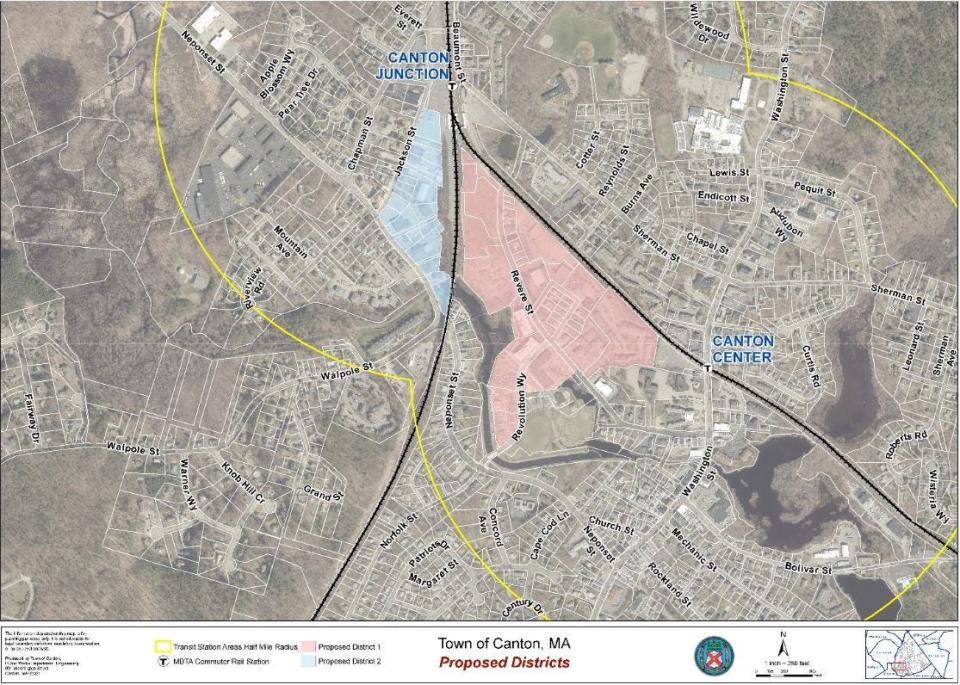
Carver
Status of MBTA zoning adoption vote: To be determined
Number of units required for MBTA zoning: 235
Carver is considered an “adjacent small town,” one of 35 across the state that faces a deadline of December 31, 2025, to adopt zoning that complies with the MBTA Communities Act.
The town must zone for at least 235 multifamily housing units, or 5% of its 4,701 housing units.
Cohasset
Status of MBTA zoning adoption vote: To be determined
Number of units required for MBTA zoning: 3,341
Cohasset voters will decide whether to adopt proposed MBTA zoning changes during June 3 town meeting.
The “commuter rail” community must zone for at least 638 multifamily housing units, accounting for 15% of its 3,341 housing units.
The town is proposing to place its district along Route 3A on the south side of the Cohasset station of the Greenbush commuter rail line. Existing developments within the proposed overlay district include Old Colony Square, Hingham Lumber Company and Extra Space Storage.
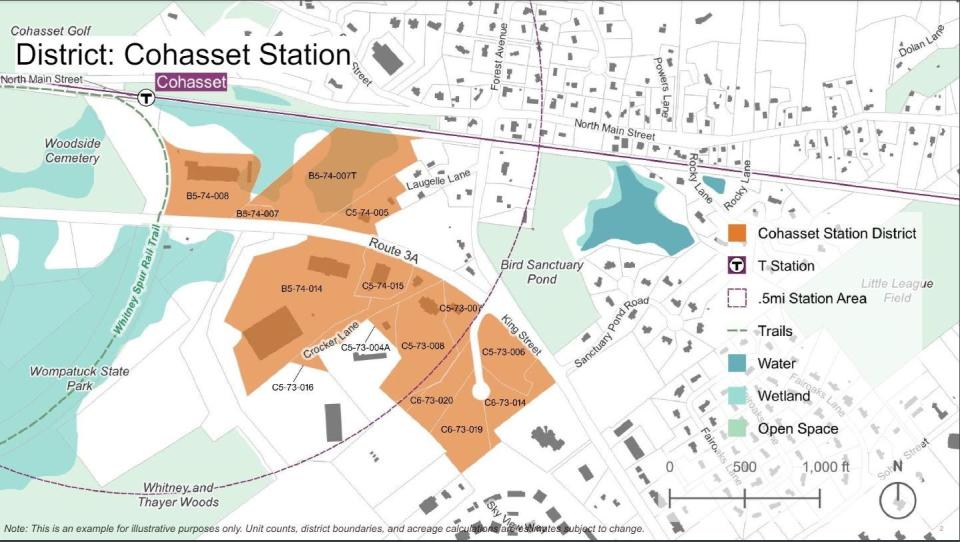
Duxbury
Status of MBTA zoning adoption vote: To be determined
Number of units required for MBTA zoning: 750
The town of Duxbury is considered an “adjacent community” and as such faces an end-of-year deadline to adopt MBTA zoning.
It’s required to zone to allow for a minimum of 750 multifamily housing units, which is 12% of its 6,274 housing units.
Duxbury Town Manager René Read said the town is just starting the MBTA zoning process, with the select board this month voted to create a study committee on the issue.
Hanover
Status of MBTA zoning adoption vote: Returned to planning board May 7
Number of units required for MBTA zoning: 750
During the second night of town meeting, Hanover voters decided by voice vote May 7 to send proposed zoning changes back to the planning board for review.
As an “adjacent community,” Hanover was required to zone for at least 750 multifamily housing units, or 14% of its 5,268 total housing units.
The MBTA overlay district as proposed covered part of Hanover Crossing.
In response to concerns raised at town meeting about the impact of any development within this zoning overlay district, Town Manager Joe Colangelo told The Patriot Ledger that he was working with department heads to prepare an impact report of how 750 apartments will affect town services. This report should be ready by Sept. 1, before the town’s fall special meeting.
The zoning change does not require that anything be built and voters were not considering any specific project.
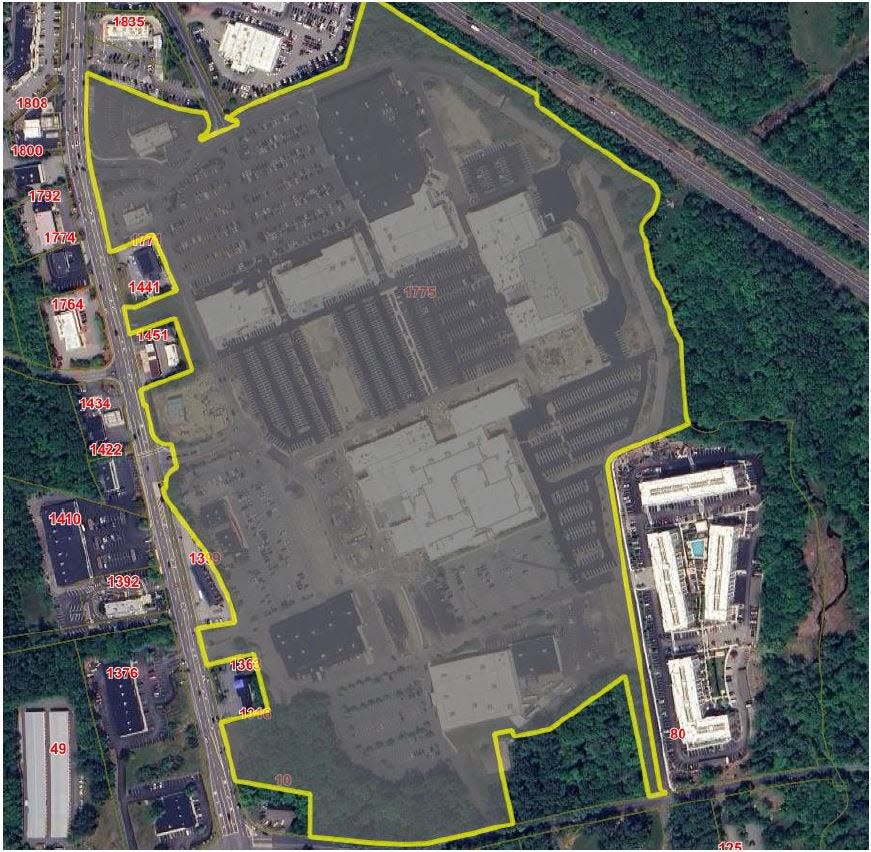
More: 3 more South Shore towns don't pass MBTA zoning rules at May town meeting
Hanson
Status of MBTA zoning adoption vote: Rejected May 6
Number of units required for MBTA zoning: 750
Voters in Hanson emphatically did not support proposed MBTA zoning changes at town meeting May 6. This was decided by a voice vote.
As a “commuter rail” community, Hanson is required to zone for at least 750 multifamily units, or nearly 19% of its 3,960 total units.
The zoning overlay district proposed on the east side of the Hanson station on the Kingston commuter rail line. It encompassed a portion of land on the south side of Route 27, but mostly on the north side, between Phillips and High streets. The overlay district covers some existing businesses but mostly an undeveloped tract of land.
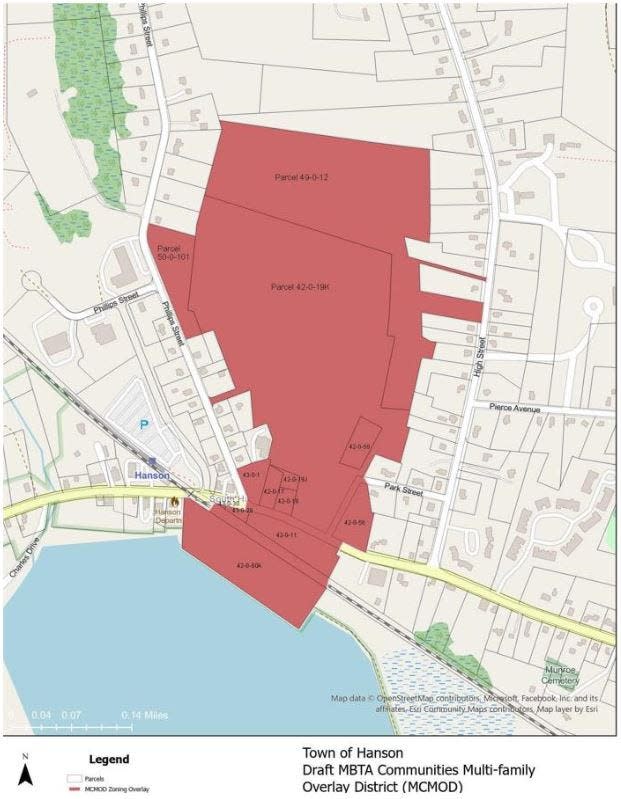
Hingham
Status of MBTA zoning adoption vote: Passed April 25
Number of units required for MBTA zoning: 1,490
The proposed MBTA zoning overlay districts were adopted by the voice vote of Hingham voters during the second night of town meeting April 25.
Hingham is a “commuter rail” community and had to create zoning for at least 1,490 multifamily housing units, which is 15% of the 9,930 total housing units in town.
The district encompasses a portion of Hingham Shipyard, 360 Beal St. and a parcel on French Street between the East Weymouth and West Hingham stations on the Greenbush commuter rail line.
Existing developments covered by this overlay district include Avalon Apartments, Hewitts Landing condos, Avalon at the Hingham Shipyard and The Cove on Beal Street.
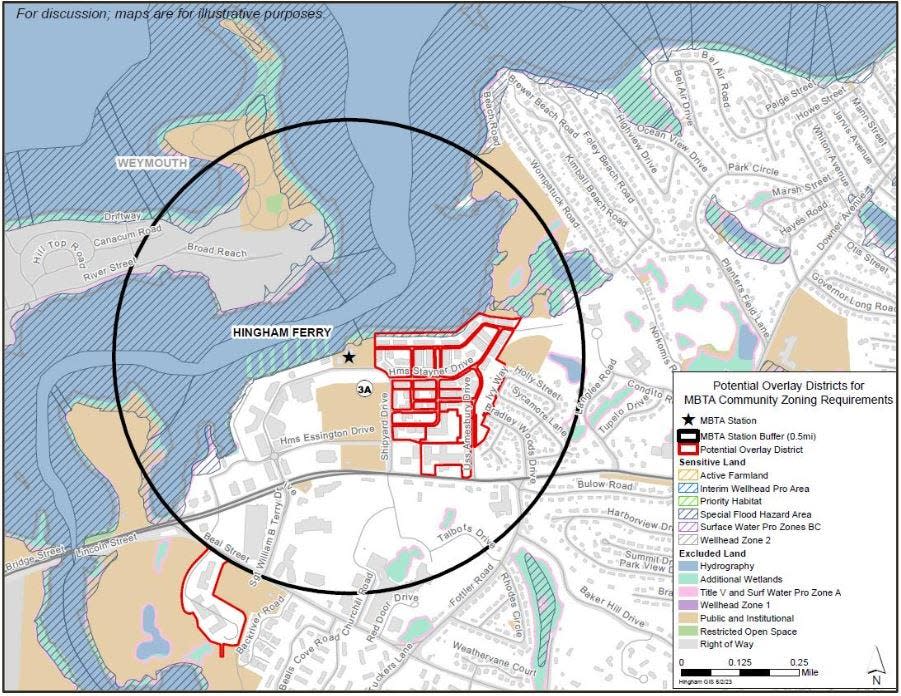
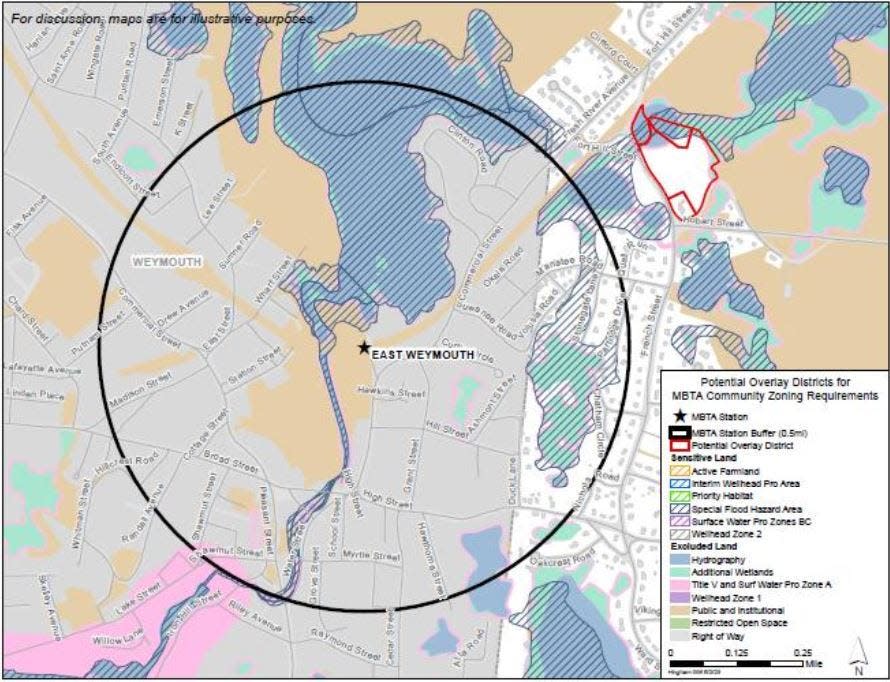
Hull
Status of MBTA zoning adoption vote: Passed May 8
Number of units required for MBTA zoning: 586
On the final night of the May town meeting, Hull voters decided by a decision of 174-74 to adopt proposed MBTA zoning rules.
The town decided to create three districts to comply with the MBTA Communities Act: the first on the east and west sides of Nantasket Avenue generally between Eastman Road and Elm Avenue; the ocean side of Nantasket Avenue roughly from Nantasket Beach Hotel to Horizons at Paragon Park; and a hook-shaped collection of parcels northwest of the intersection of Atlantic and Valley Beach avenues that include Atlantic Hill Condominium II and The Oceania Residences.
The town was required to zone for 586 multifamily housing units, or 10% of the 5,856 total housing units in Hull. It is considered an “adjacent community.”
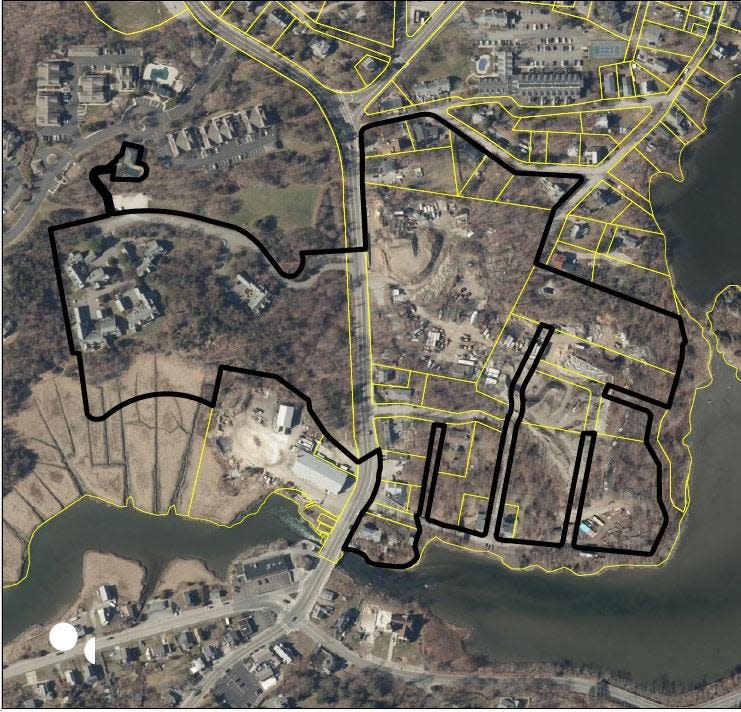
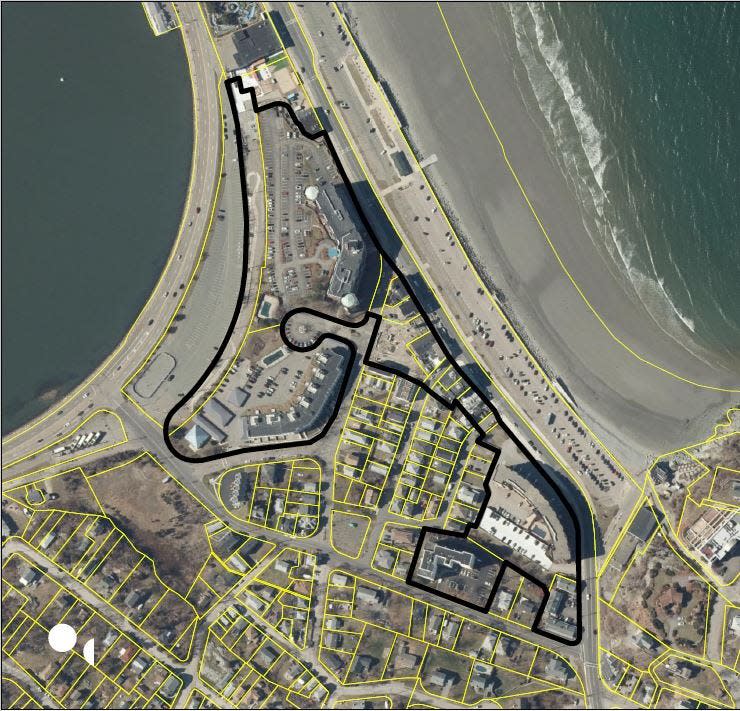
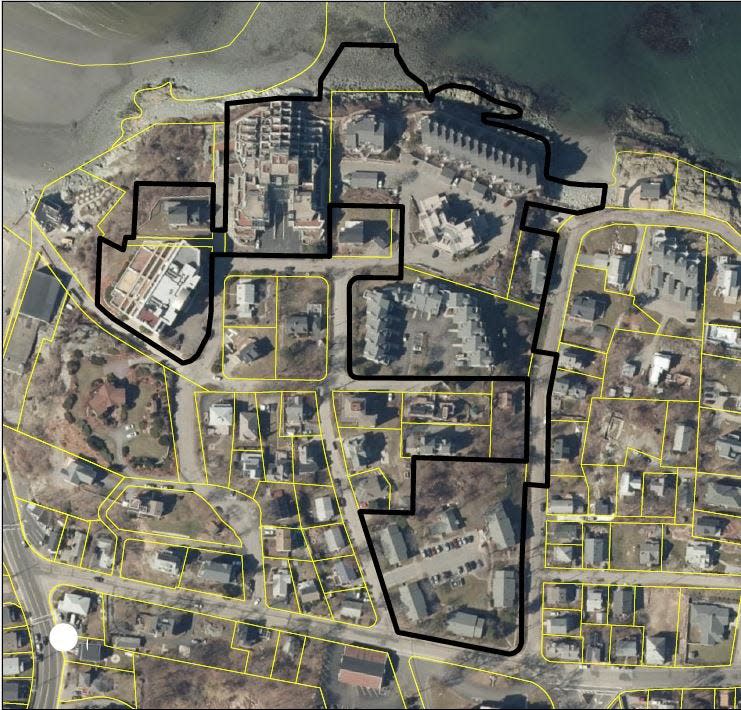
Kingston
Status of MBTA zoning adoption vote: To be determined
Number of units required for MBTA zoning: 805
Kingston has to zone for 805 multifamily housing units, or almost 16% of the 5,364 housing units in total.
The town is considered a “commuter rail” community and proposed overlay districts cover a portion of the Kingston Collection mall, The Point at Kingston apartments and an industrial park on the north side of Independence Mall way.
Town Planner Valerie Massard told The Patriot Ledger that Kingston residents will vote on the proposal at October's fall town meeting.
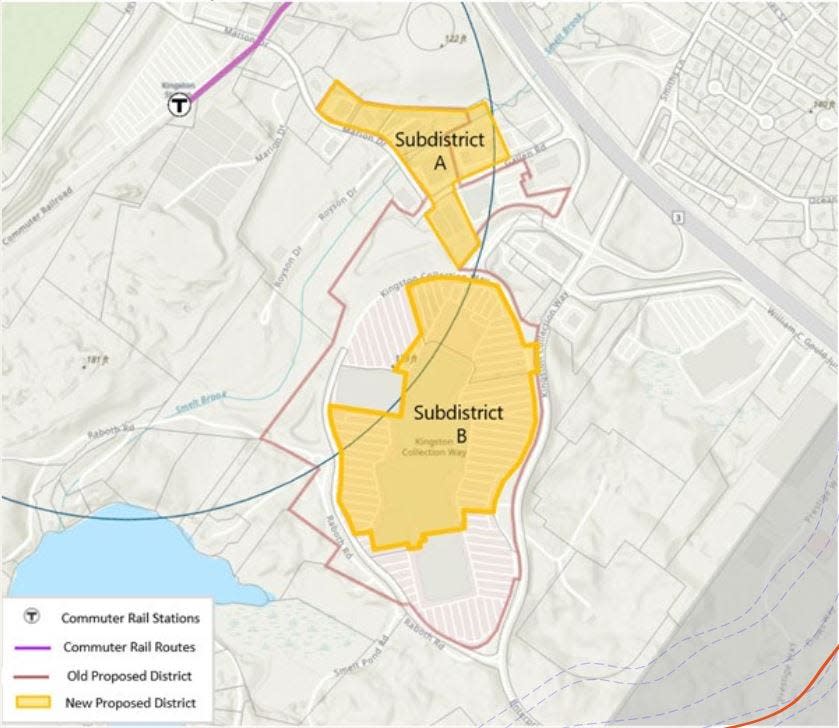
Marshfield
Status of MBTA zoning adoption vote: Rejected April 22
Number of units required for MBTA zoning: 1,158
Voters in Marshfield rejected the proposed MBTA zoning overlay district during town meeting April 22 by a vote of 289-169.
The change covered 84 acres on the north side of Route 139 and east of School Street. The area is mostly built out with existing businesses and homes.
The town, an “adjacent community,” is required to zone for 1,158 multifamily housing units, which makes up 10% of the existing 11,575 housing units.
In a post on the Marshfield town website, Town Counsel Bob Galvin said he relayed how residents felt about the law and “did offer the points of view espoused by many that the state was overbearing in acting to require this where the town has made significant progress towards affordable housing.”
“At this point, they do not intend to bring a suit against Marshfield in the immediate future in the hope that Marshfield will reconsider its position in the fall even after the Milton case is decided,” he said in the post.
The state will consider Marshfield in “interim compliance” until the end of year. If after that point the town still has not adopted zoning, the state’s Executive Office of Housing and Livable Communities will send the town a letter to confirm their status and “that will be followed by a lawsuit to compel compliance,” Galvin said.
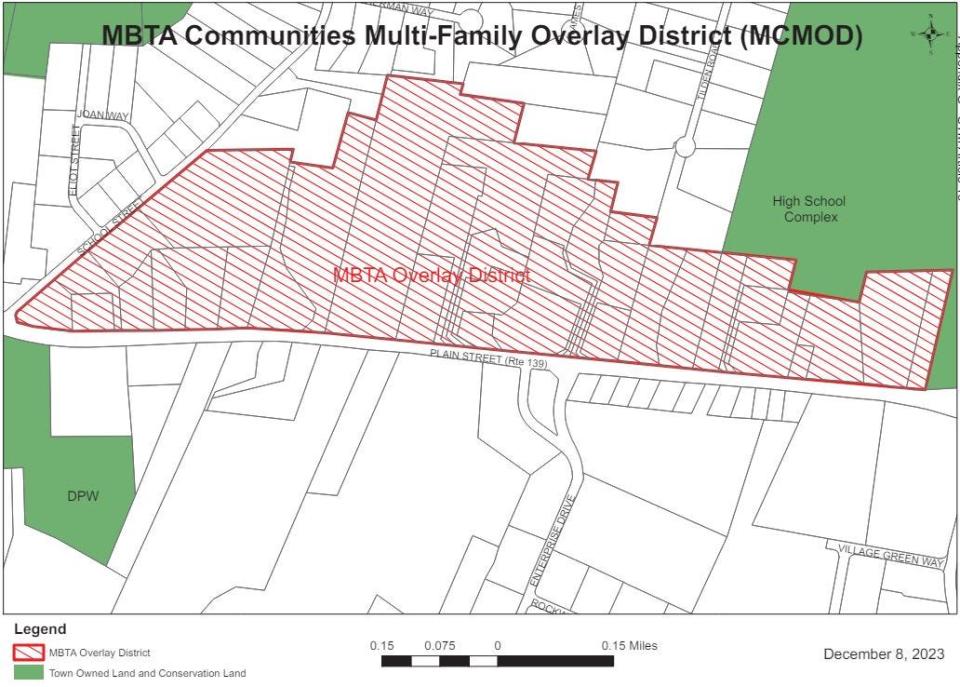
Milton
Status of MBTA zoning adoption vote: Rejected Feb. 14
Number of units required for MBTA zoning: 2,461
Milton became the first South Shore community to reject proposed MBTA zoning changes and as a result was sued.
Voters initially passed proposed changes at town meeting in December, but came back in February during a special election and overturned the decision.
Because Milton is a “rapid transit” community and faced a December 2023 deadline to adopt zoning, the state moved forward with a lawsuit to compel the town to comply and revoked a $140,800 seawall grant.
The town was required to zone for 2,461 multifamily housing units, or 25% of the 9,844 total housing units in Milton.
The proposed districts covered an area along the trolley line from Blue Hills Parkway to Adams Street, with two other areas near the Interstate 93 interchange and surrounding the intersection of Adams Street and Granite Avenue.
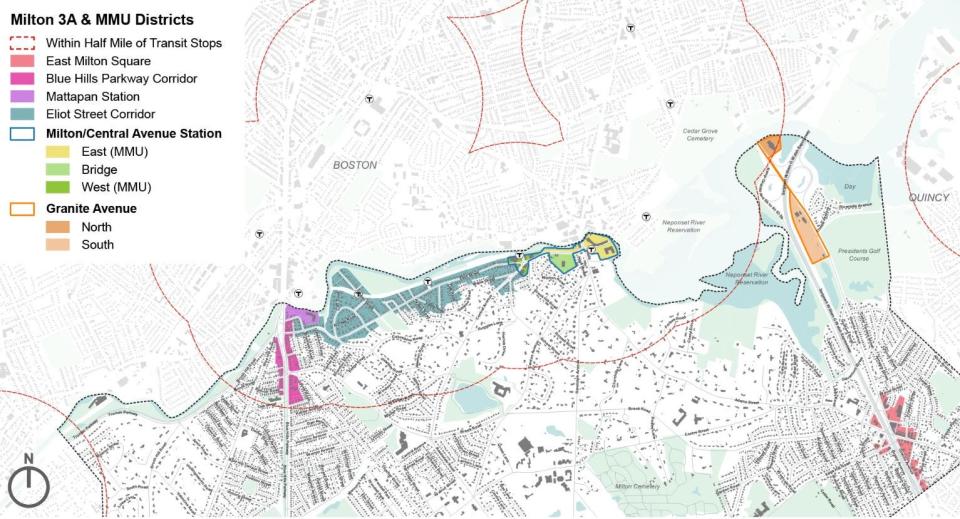
Norwell
Status of MBTA zoning adoption vote: Rejected May 6
Number of units required for MBTA zoning: 750
Voters in Norwell decided to reject proposed MBTA zoning by a vote of 329 against and 241 for during their town meeting May 6.
The town is required to zone for at least 750 multifamily housing units, or nearly 20% of their 3,805 total housing stock. Norwell is considered an “adjacent community.”
The proposed MBTA zoning in Norwell would have centered along Accord Park Drive and Pond Street, between Pilgrim Highway and Route 53.
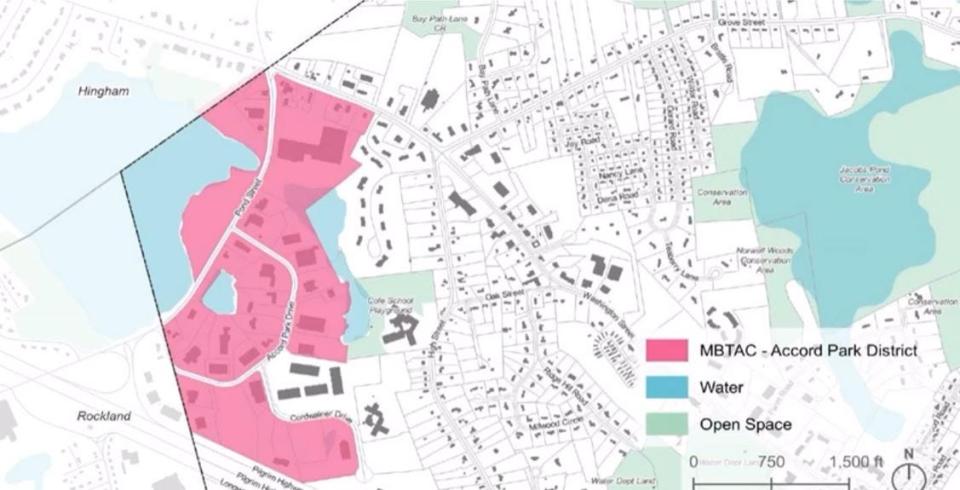
Pembroke
Status of MBTA zoning adoption vote: Passed May 9, 2023
Number of units required for MBTA zoning: 750
Pembroke was an early adopter to MBTA zoning changes, with town officials citing minor tweaks to existing zoning for the town to be in compliance with the state.
Voters passed these changes by voice vote during the May 9, 2023, town meeting.
The town made changes to allow multifamily housing in the existing Industrial A and Industrial B zoning districts. These districts are concentrated on the Pembroke/Marshfield border around the Route 3 interchange, an area that is already built with a number of commercial properties like Lowe’s and Stop & Shop.
As an “adjacent community,” Pembroke is required to create zoning that allows for at least 750 multifamily housing units, or almost 11% of the 7,007 existing housing units in town.
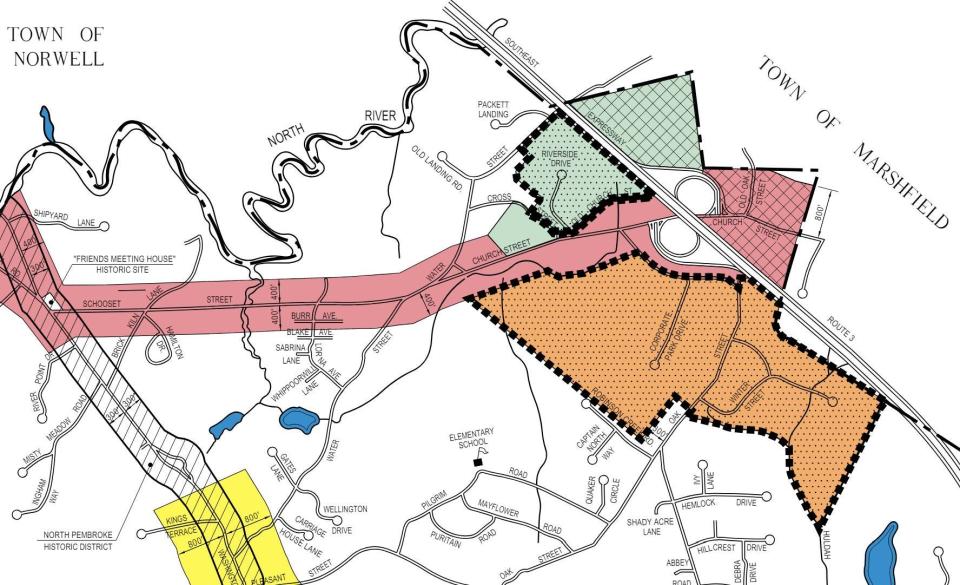
Plymouth
Status of MBTA zoning adoption vote: Passed April 6
Number of units required for MBTA zoning: 2,807
Plymouth voters adopted MBTA zoning changes during town meeting April 6 by a vote of 127-6.
The town, as an “adjacent community,” is required to zone for at least 2,807 housing units, or 10% of the 28,704 existing housing units.
The zoning changes cover four parts of town: a portion of Cordage Park to the Pier at Cordage; existing multifamily developments on Plaza Way near the Plymouth-Kingston border; The Oasis at Plymouth; and multifamily developments near The Market off of Clark Road.
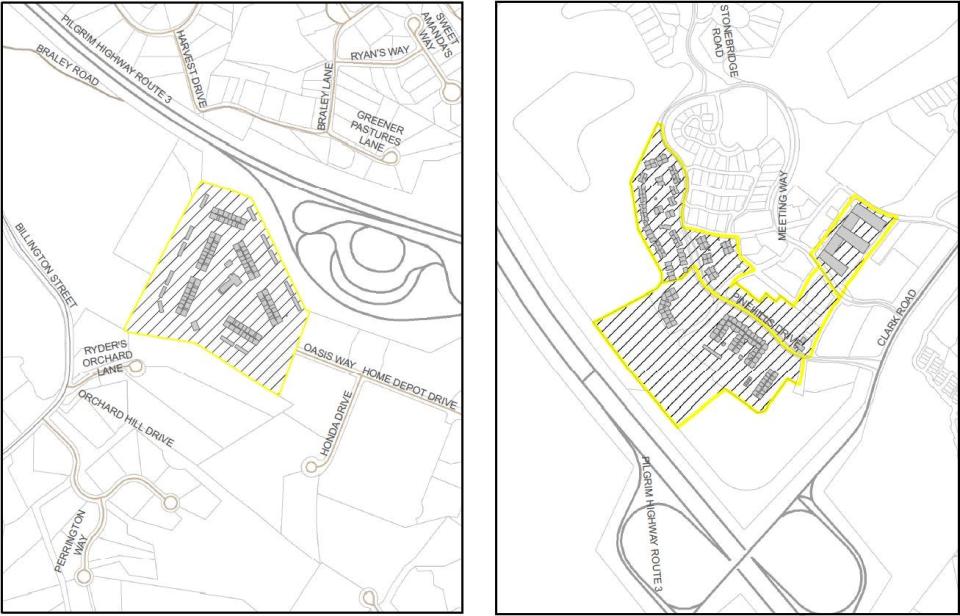
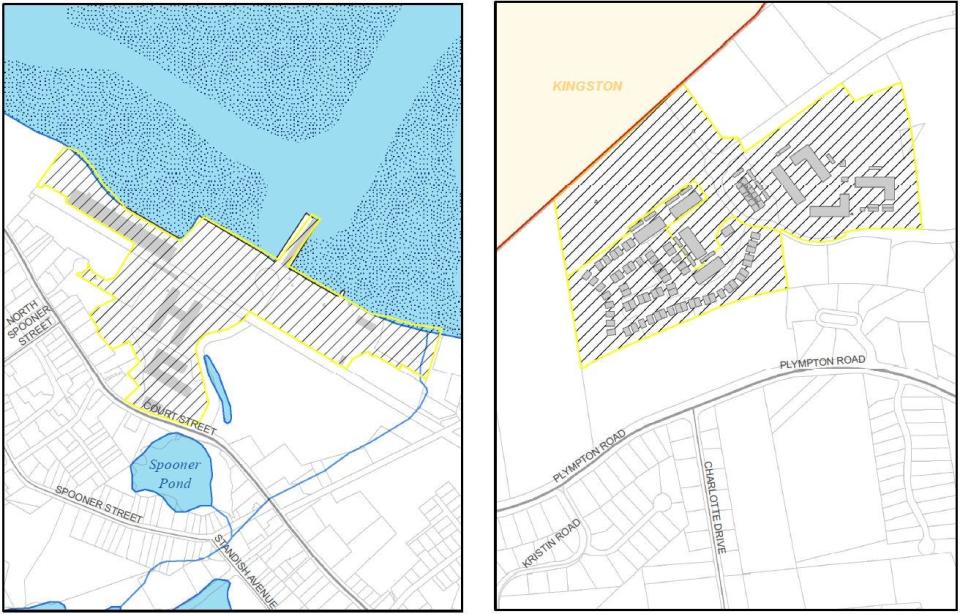
Randolph
Status of MBTA zoning adoption vote: To be determined
Number of units required for MBTA zoning: 1,935
Randolph is considered a “commuter rail” community and is required to zone for at least 1,935 multifamily housing units, or 15% of the existing 12,901 housing units.
No vote has taken place as of May 2024.
“The town is actively working toward establishing districts that would comply with the Chapter 3A requirements in order to submit a zoning map amendment…. I do not anticipate a problem meeting that deadline,” said Michelle Tyler, director of planning.
Rockland
Status of MBTA zoning adoption vote: Passed May 6
Number of units required for MBTA zoning: 726
Voters in Rockland adopted proposed MBTA zoning changes during town meeting May 6.
The town, as an “adjacent community,” was required to zone for at least 726 multifamily housing units, or 10% of its 7,263 existing housing units.
The overlay district encompasses an area with existing commercial developments like 3M, a Comfort Inn and car dealerships. It is located north of Hingham Street and south of Route 3.
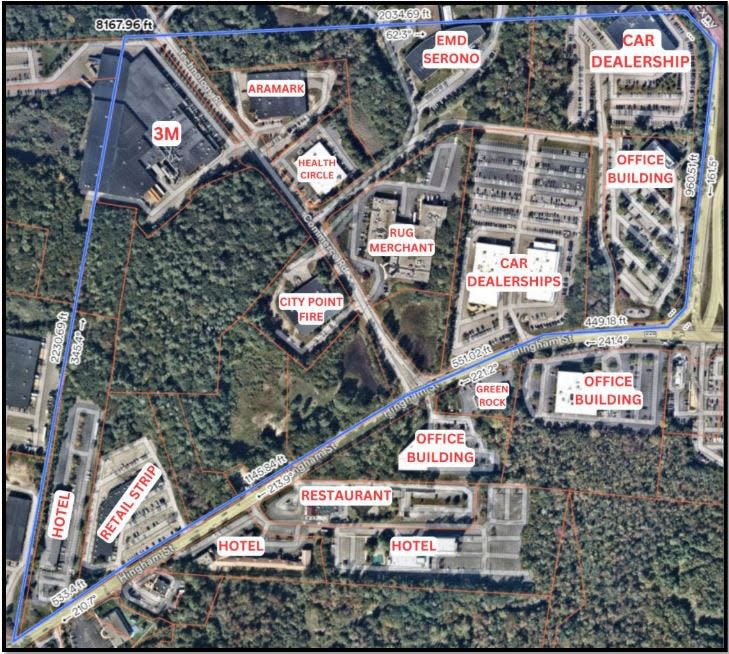
Scituate
Status of MBTA zoning adoption vote: Passed April 18
Number of units required for MBTA zoning: 1,239
Scituate voters adopted proposed MBTA zoning changes during town meeting April 18.
The zoning overlay districts are concentrated around the two commuter rail stations, North Scituate and Greenbush.
The “commuter rail” community had to zone for 1,239 multifamily housing units, or 15% of the 8,260 housing units already in town.
The tweaks amounted to “housekeeping changes,” town officials said, as zoning for this type of development was already completed.
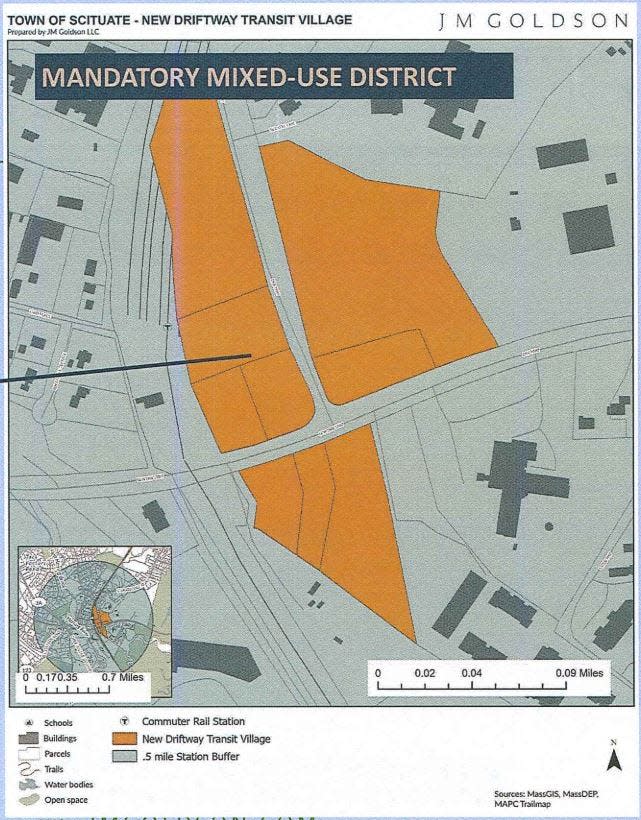
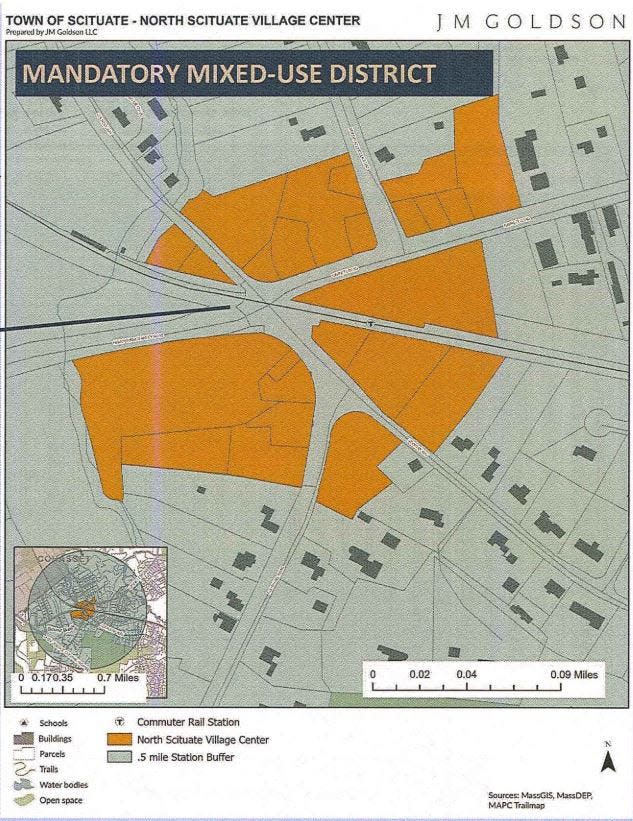
Weymouth
Status of MBTA zoning adoption vote: Submitted to state April 4
Number of units required for MBTA zoning: 3,813
Town officials submitted its proposed MBTA districts to the state April 4. A public vote by the town council or the public was taken because it was not required for municipalities with a city form of government, said the town’s principal planner Eric Schneider.
The town chose the Weymouth portion of Union Point and Jackson Square as its MBTA zoning overlay districts. The town council already approved zoning changes for these areas closely in line with, but not explicitly for, the MBTA Communities Act.
The town, a “commuter rail” community, was required to zone for 3,813 multifamily housing units, or 15% of the 25,419 housing units that exist in town.
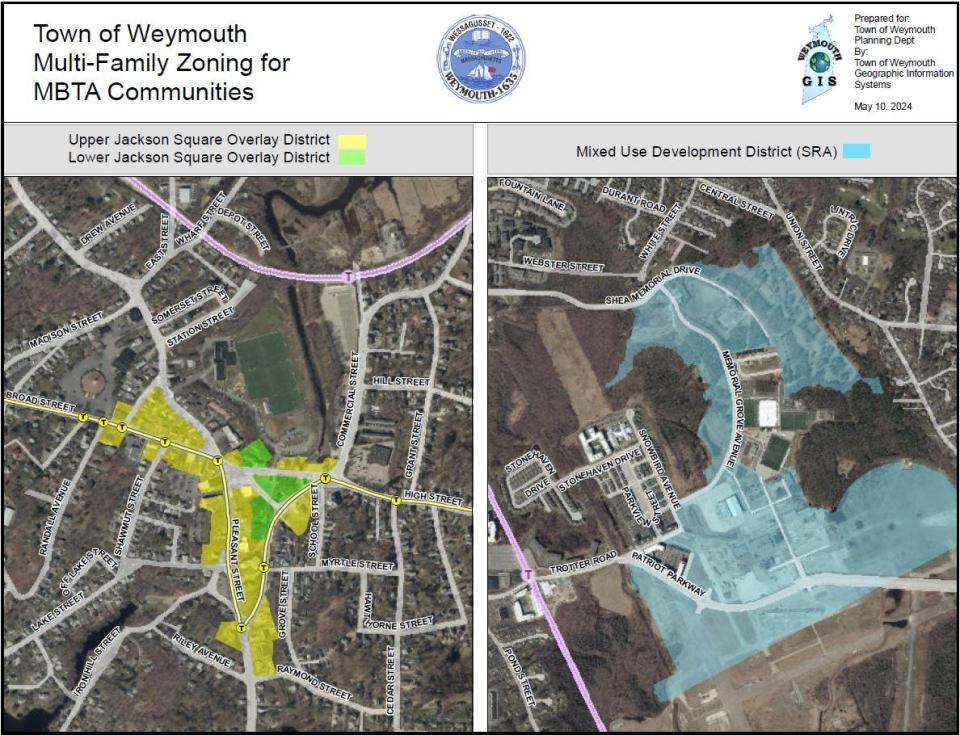
Whitman
Status of MBTA zoning adoption vote: Passed May 6
Number of units required for MBTA zoning: 898
Voters in the town of Whitman decided to adopt MBTA zoning changes by a voice vote during town meeting May 6.
The “commuter rail” community had to zone for 898 multifamily housing units, which accounts for 15% of the town’s 5,984 existing housing units.
The zoning district follows several parcels on either side of the Kingston commuter rail line from Lyons Lane to the station off South Avenue.
See you tonight at 7:30
Town Meeting digital guide:
Follow the warrant : https://t.co/beCarixZrX
Attached is the map for the MBTA Communities we’ll be discussing in Article 50#mapoli pic.twitter.com/zbOsD6SLH1— Justin Evans (@VoteJustinEvans) May 6, 2024
Quincy
Status of MBTA zoning adoption vote: Passed Dec. 18, 2023
Number of units required for MBTA zoning: 11,752
The City Council voted on MBTA zoning changes Dec. 18, 2023.
The city had to create zoning that would allow for 11,752 multifamily housing units, or 25% of the 47,009 housing units counted in the 2020 census.
Quincy is a “rapid transit” community. Its two new zoning overlay districts are in West Quincy near the Quincy Adams T station and an area in North Quincy that covers The Abby, office buildings and parking lots.
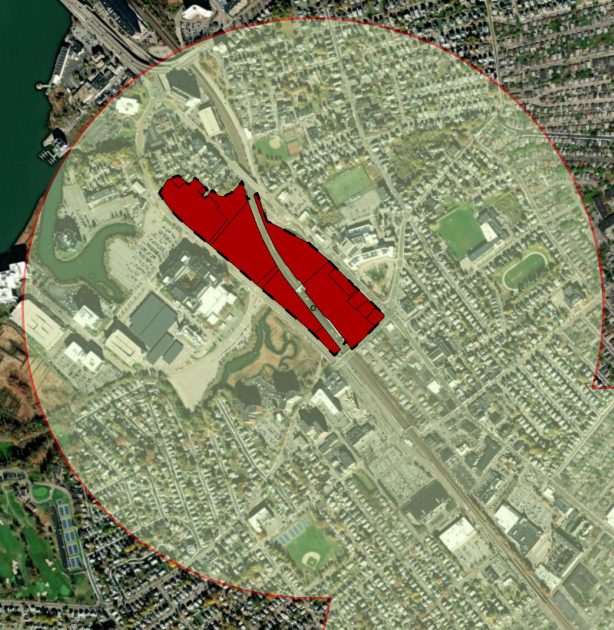
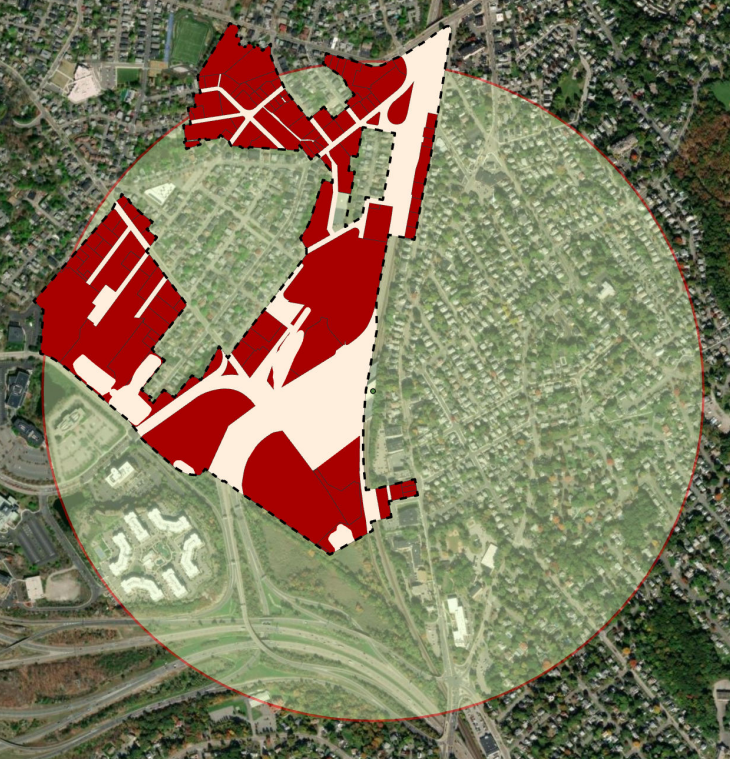
Hannah Morse covers growth and development for The Patriot Ledger. Contact her at hmorse@patriotledger.com.
This article originally appeared on The Patriot Ledger: MBTA Communities Act: Where South Shore proposes multifamily zoning

